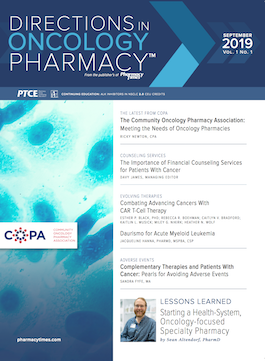Publication
Article
Pharmacy Practice in Focus: Oncology
Medical Marijuana in Community Oncology
Author(s):
During a presentation at the recent Community Oncology Alliance Annual Conference in Orlando, Florida, Ray Bailey, RPh, discussed the implications of medical marijuana for patients with cancer.
During a presentation at the recent Community Oncology Alliance Annual Conference in Orlando, Florida, Ray Bailey, RPh, discussed the implications of medical marijuana for patients with cancer. The term “cannabis” is delightfully simple compared with the chemical complexity associated with a breakdown of the plant. More than 100 cannabinoids have been identi ed to date, from the better known delta-9-tetrahydrocannabinol (THC)—the psychoactive component of the substance— to terpenoids and avonoids that present themselves in everyday substances.
The cannabis plant produces phytocannabinoids and cannabinoids in the form of carboxylic acids, which are converted to chemically neutral forms that activate in the human body after exposure to direct heat or over time at room temperature. The endocannabinoid (CB) system in the body is how marijuana creates its physiological responses. With receptors all over, it is the largest neural pathway in the human body. These receptors were identified approximately 25 years ago and may play a much larger role in the human body than previously realized.
As most pharmacists would predict, smoked and vaped cannabis shows its maximum concentration more rapidly than ingested cannabis. Dose titration is more
of an option with the smoked and vaped versions because there is less variability in dose response and metabolism than ingested cannabis. The euphoria associated with THC use is well documented, but there are adverse effects (AEs) associated with its use, including blurred vision, anxiety, and headache.
Some of these AEs can be debilitating and will rule out certain patients from using medical cannabis. Both THC and cannabidiol (CBD) are metabolized through some of the more standard cytochrome P450 (CYP) pathways—3A4, 3A5, 2C9, 2C19—so drug interactions should be monitored closely. Smoking itself can induce CYP1A2 and thus increase the clearance of some antidepressants and antipsychotics.
Bailey noted that published clinical research studying marijuana shows a wide scope of promise for Alzheimer disease, migraine headaches, multiple sclerosis, and diabetes. Focusing on cancer, Bailey said that scientific evidence strongly supports the use of medical cannabis for pain, chemotherapy-induced nausea and vomiting, appetite stimulation, and sleep. A 2017 National Academies of Sciences, Engineering, and Medicine report rated the evidence for treating cancer pain with cannabis as “strong,” concluding that lesser-quality research supports its use in treating some of the other symptoms.
Although it has been found that cachexia associated with HIV/AIDS can be effectively treated with THC, evidence does not support the use of THC for cachexia in patients with cancer, according to Bailey. However, studies that have examined the ability of cannabis to be a primary treatment for cancer. Bailey cited a small pilot study from 2006 that found clinical improvement in 3 of 9 patients who received an injection containing a THC solution applied directly to the tumor. Specifically, these patients had glioblastoma multiforme and the trial was initiated after all conventional treatments were exhausted.
THC and CBD each has a somewhat specific clinical profile. Mainly working on the CB1 receptor, THC is known for being anti-inflammatory, analgesic, and neuroprotective, while reducing intraocular pressure, spasticity, and muscle tension. Although its psychoactiva- tion component may present dangerous situations, no brain stem activity in response to use of THC means no established lethal dose. Bailey noted that CBD appears to be more neuroprotective with less psychoactivity and is the most prevalent phytocannabinoid in hemp. In Israel, CBD compounds are used in patients who have suffered a stroke as an alternative to tissue plasminogen activator.
The challenge in marijuana regulation and mass production is how can we guarantee what patients are getting if we have yet to discover more chemical compounds in this plant? These compounds are thought to work together to create different outcomes for different disease states and affect the human mind in unique ways, according to Bailey.
A great example of a strain with slight psycho-activity but strong clinical activity is Charlotte’s Web. This strain, CBD-heavy for children with treatment-resistant seizures, was popularized after an appearance on the CNN program Chasing Life with Dr. Sanjay Gupta.
With more states approving medical and recreational cannabis programs, a lot of legal gray areas have been introduced. But make no mistake that marijuana is still classified as a schedule 1 substance through the Drug Enforcement Administration (DEA) and any licensed pharmacy is placing their DEA license on the line by supplying marijuana, even if it’s legal at the state level.
David Book, PharmD







